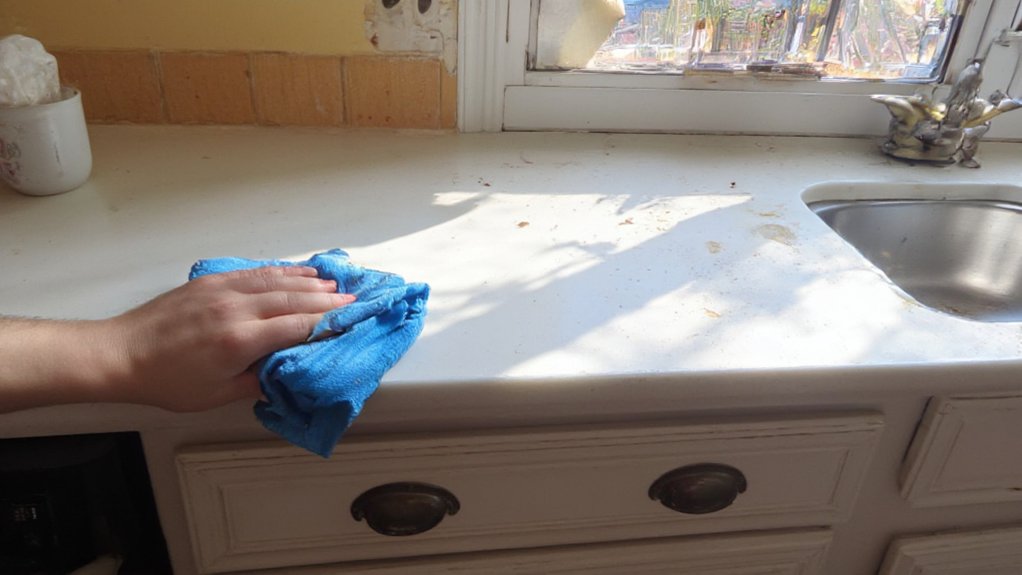Hey, let’s tackle making your kitchen countertop together! I’ve had my share of DIY blunders—once cut a piece too short by a whole inch, ugh!—but I’m here to guide you. Start by measuring your space with a tape measure, down to the 1/8 inch, trust me!
Curious how to pick the perfect material without breaking the bank? Stick with me for the next steps!
Before You Start
Before you plunge into making your kitchen countertop, let’s chat about getting ready for this awesome project! I’ve messed up before, trust me, and skipping prep is a recipe for disaster—ha!
First, clear your workspace. Make sure you’ve got a solid 8×4 foot area—clutter’s your enemy! Sweep away debris and double-check for hazards.
Next, plan your timeline. Set aside a full weekend; rushing leads to goofy mistakes (I’ve been there!). Mark a calendar for a stress-free pace.
Finally, protect your space! Lay down drop cloths—10×12 feet works best. Prep now, and you’re golden!
What You Will Need
Hey there, now that we’ve got the prep work sorted, let’s chat about rounding up everything you’ll need to build this kitchen countertop! I’ve messed up before by forgetting stuff, so trust me, get this list ready!
Here’s what you’ll grab for the job:
- Plywood Sheet: Get a 3/4-inch thick, 4×8 foot piece for a solid base.
- Countertop Material: Laminate or butcher block, cut to 25×72 inches.
- Circular Saw: For precise cuts—don’t wing it!
- Wood Glue: Strong stuff, like Titebond III.
- Screws: 1.5-inch wood screws, a full pack.
Let’s avoid my past DIY disasters together! Woo-hoo!
Step-by-Step Guide
Hey, let’s get rolling on crafting that dream kitchen countertop together—I’m pumped to help you out! You’ll start by measuring your countertop space, picking the right material, cutting it just right, securing those edges, and setting up solid supports. Man, I’ve messed up a cut or two before, so trust me, we’ll take it nice and easy!
1. Measure Your Countertop Space
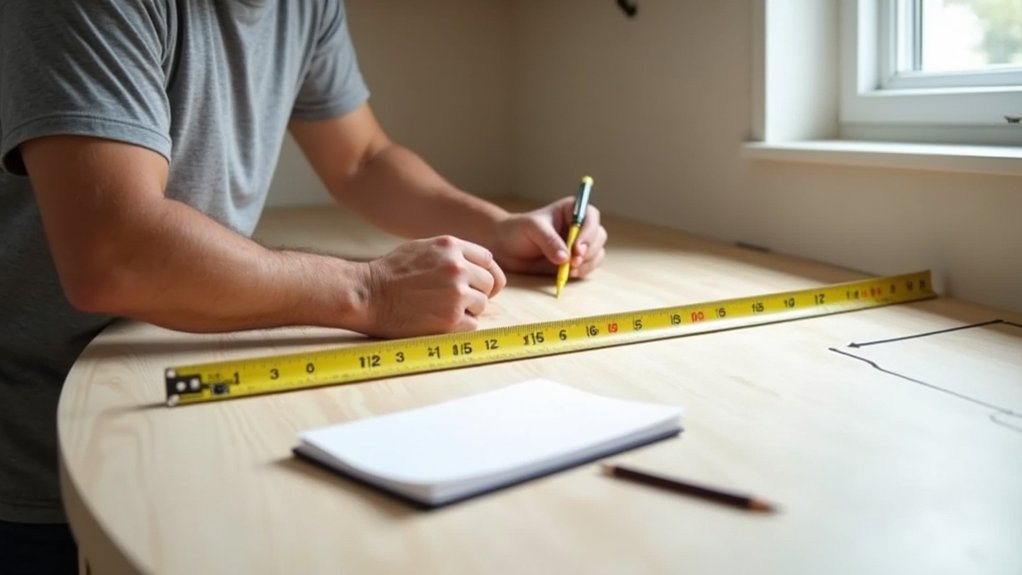
Man, measuring your countertop space is the absolute first step to getting this DIY project rolling, and I’m pumped to guide you through it! Trust me, I’ve botched this before by guessing—disaster! Let’s nail it together.
Grab a tape measure and notepad. Measure the length and width of your counter area in inches. Got a corner? Measure each section separately!
- Note every nook—sinks, outlets, anything funky.
- Double-check numbers. I’ve mixed up mine—ugh!
Sketch a quick layout with those measurements. Label everything clearly. You’re setting the stage for an awesome countertop, and I’m rooting for ya!
2. Choose Countertop Material

Five key options await when you’re picking out your countertop material, and I’m thrilled to help you decide! Man, I’ve botched this step before—don’t make my mistakes! Let’s explore your choices.
First, consider granite—it’s tough, gorgeous, and lasts forever, though it’s pricey at $40-$100 per square foot. Quartz is next; it’s low-maintenance and around $50-$120 per foot. Laminate’s super cheap, $10-$30 per foot, but scratches easy (ugh, learned that the hard way!). Marble screams luxury at $40-$180, yet stains fast. Finally, butcher block wood, $20-$60, feels warm but needs sealing. Which fits your vibe? Choose wisely!
3. Cut Material Precisely
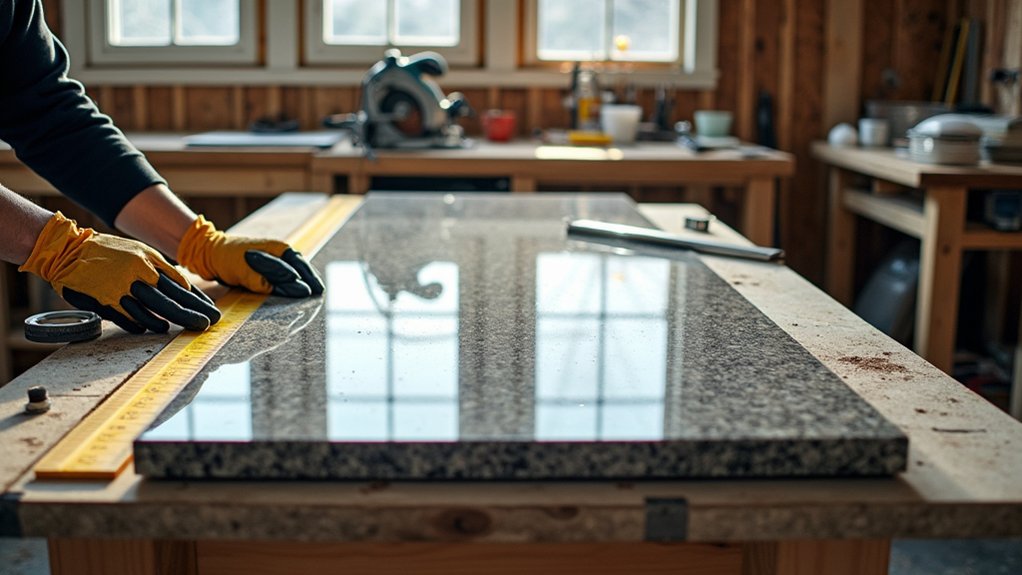
After you’ve picked your countertop material, it’s time to plunge into the nitty-gritty of cutting it precisely—trust me, this step can make or break your project! I’ve botched cuts before, and it’s a headache. Let’s avoid that!
First, measure twice—use a tape measure for exact lengths, like 36 inches for a standard counter depth. Mark your lines with a pencil. Grab a circular saw (I swear by my DeWalt!) for straight cuts.
- Set blade depth to 1/8 inch past material.
- Cut slowly—don’t rush!
Man, steady hands save the day! Keep it precise, and you’re golden!
4. Secure Countertop Edges
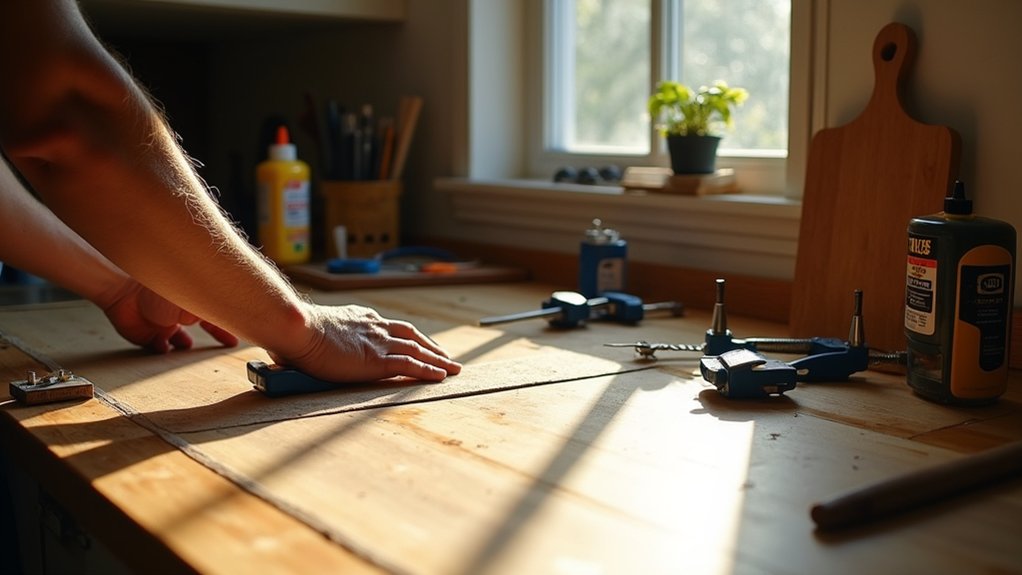
Hey there, now that we’ve got those cuts looking sharp, let’s move on to locking down those countertop edges before they decide to go rogue on us! I’ve had an edge slip once—talk about a disaster!
First, gather your tools. You’ll need:
- Wood glue (Gorilla brand works great)
- Clamps (at least 4, 12-inch size)
- Sandpaper (120-grit)
Now, apply a thin bead of glue along the edge joint. Press the edging strip—cut to 1/8-inch overhang—against the countertop side. Clamp it tight every 6 inches! Let it dry for 24 hours. Trust me, don’t rush this step! Wow, it’s secure!
5. Install Countertop Supports
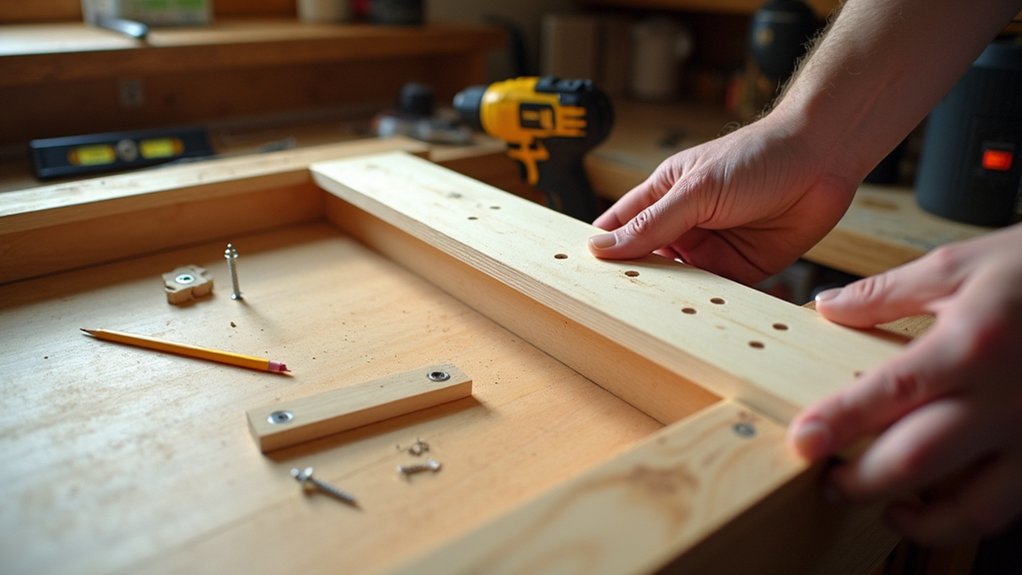
Man, securing those edges was a big win, but now let’s tackle the next essential step—installing countertop supports to keep everything rock-solid! I’ve messed up before by skipping this, and trust me, a wobbly counter is no joke.
Start by grabbing ¾-inch plywood strips, cut to 4 inches wide. Lay ‘em along the cabinet tops, securing with wood screws every 12 inches. Man, that drill buzzes like a beehive! Check they’re level—use a spirit level, okay? If not, shim ‘em up with wood wedges. Whew, steady now! Your countertop’s gonna sit tight with this backbone!
6. Seal Countertop Surface
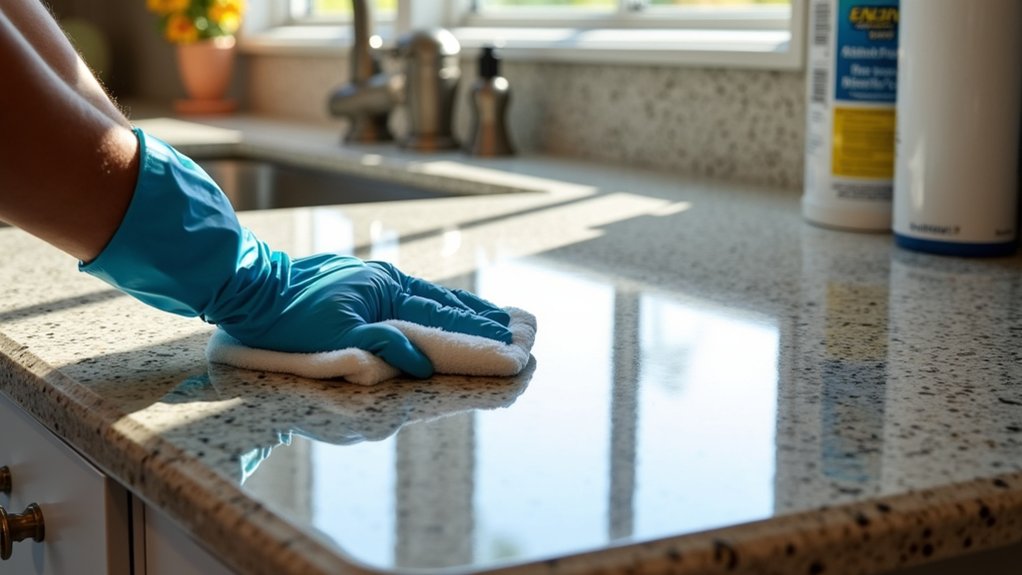
Alright, with those countertop supports locked in tight, let’s move on to sealing the surface to protect your hard work! I’m thrilled to see it shaping up—wow, what a beauty! But, trust me, unsealed counters soak up spills like a sponge (yep, learned that the messy way).
First, grab a quality sealer—like StoneTech BulletProof, about $30 for a quart. Clean the surface with mild soap; no grit left behind!
Next, apply sealer evenly using a soft cloth:
- Work in 3-foot sections.
- Wait 15 minutes, then wipe excess.
- Let it cure for 24 hours. Easy, right?
7. Attach Countertop to Cabinets
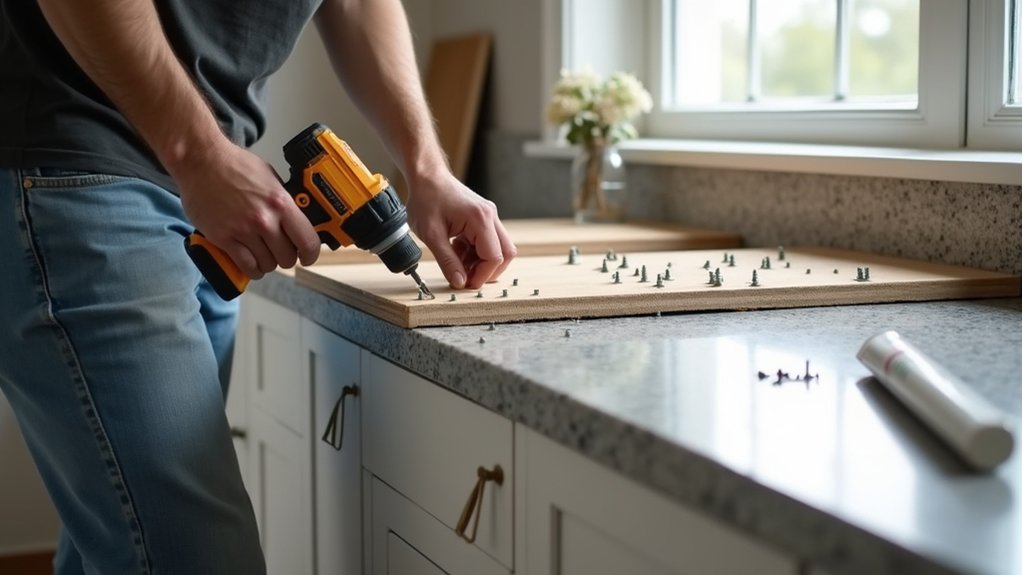
Five essential steps stand between you and a rock-solid countertop installation, and I’m pumped to guide you through attaching it to your cabinets! Let’s nail this together, okay?
First, gather your tools: a drill, 1.5-inch wood screws, and silicone adhesive. Double-check your countertop’s position on the cabinets—don’t wanna mess this up! Next, apply a thin bead of silicone along the cabinet tops for extra grip. Then, drill pilot holes (1/8-inch bit) through the cabinet frame into the countertop’s underside. Finally, secure with screws, but don’t overtighten—yikes, I’ve snapped a screw before! Tighten just enough to hold firm!
8. Test Countertop Alignment
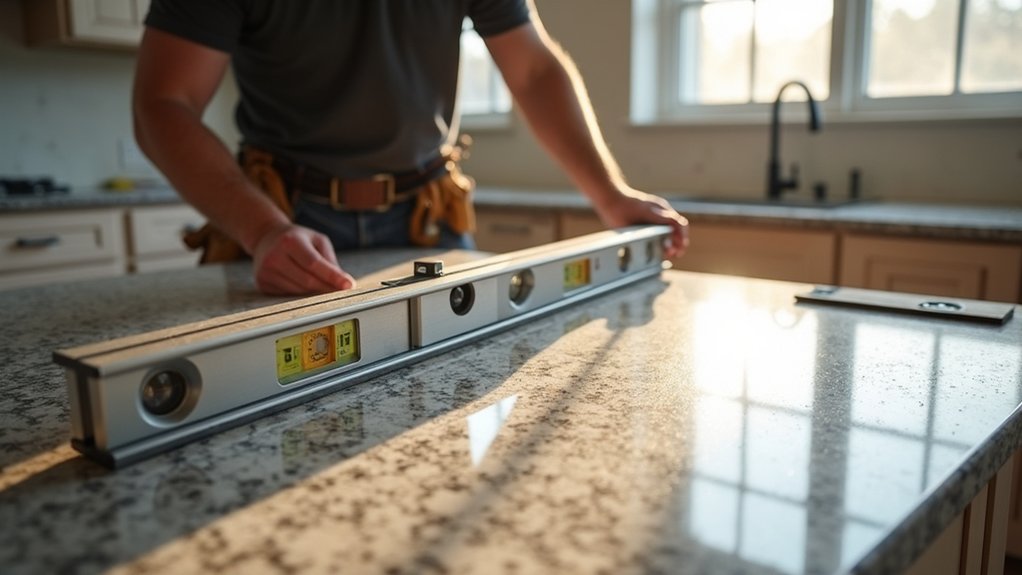
Before you start celebrating your countertop masterpiece, let’s make sure it’s lined up perfectly—I’ve learned the hard way that a wonky counter is a recipe for spills and frustration! Man, I’ve had coffee cups roll right off before. Let’s avoid that!
Grab a level (a 24-inch one works great) and place it across your countertop. Check side-to-side and front-to-back. If it’s off by more than 1/8 inch, shim it with thin wood strips under the low spots. Test multiple spots—trust me, one wobbly corner ruins everything! Adjust until it’s spot-on. Phew, perfection awaits!
9. Clean Countertop Thoroughly
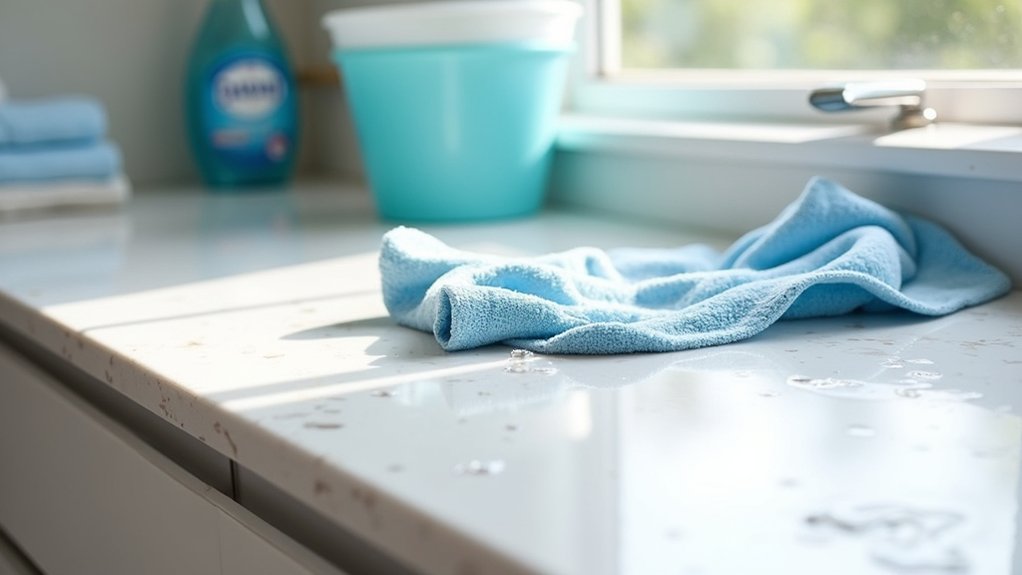
Since you’ve got your countertop aligned just right, let’s tackle the next big task—cleaning it up! Man, I’ve had dust everywhere after installs—such a mess! Stick with me, and we’ll get it spotless.
First, grab these supplies:
- Mild dish soap (like Dawn, 1 tsp)
- Warm water (1 gallon)
- Soft microfiber cloths (2-3)
Mix that soap into the water in a bucket. Dip your cloth, wring it out, and wipe down the entire countertop—don’t skip corners! Scrub gently over a 2×2 foot area at a time. Rinse the cloth often. Wow, look at that shine already!
10. Apply Final Polish
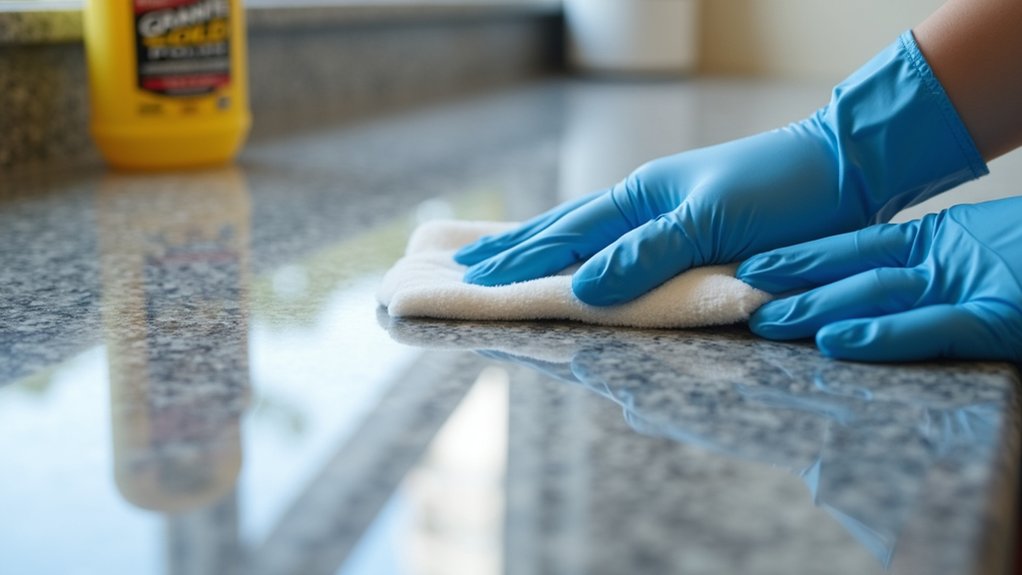
Hey, now that we’ve got that countertop wiped down and sparkling, let’s give it the ultimate glow with a final polish! I’m so excited to see it shine—trust me, it’s worth it! Grab your polish; I use “Granite Gold Polish” for that wow factor.
Here’s how you do it:
- Squirt a small dime-sized dab onto a microfiber cloth.
- Rub it in circular motions over a 2-foot section. Don’t glob it on—yep, I’ve done that and made a mess!
- Buff it off with a dry cloth. Look at that gleam! You’ve nailed it!

